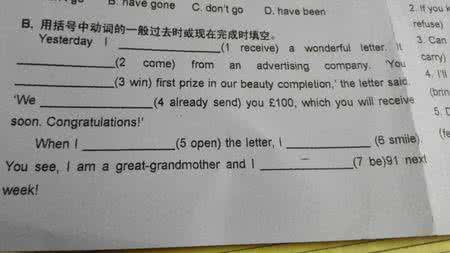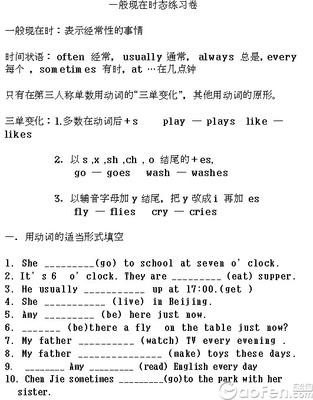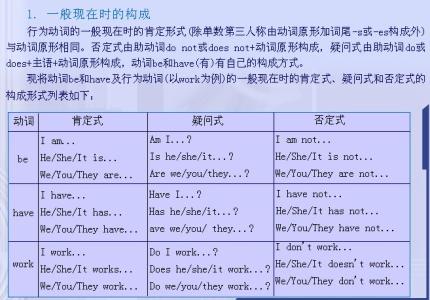Tom _____ _____ to stay at home on Sunday.
2. He can seldom finish his homework by himself, _____ _____? (反意疑问句)
3. The teacher told us it. England is an island. (改为宾语从句)
The teacher told us England ______ an island.
4. The Pacific Ocean is the largest ocean in the world. (同义句)
The Pacific Ocean is larger than ______ _____ ocean in the world.
5. It is a nice sunny day today. (感叹句)
_______ _______ nice sunny day it is today! 题型:句型转换难度:中档来源:期末题
1. doesn't have 2. can he 3. is 4. any other 5. What a
考点:
考点名称:一般现在时一般现在时::表示通常性、规律性、习惯性的状态或者动作(有时间规律发生的事件)的一种时间状态。 一般现在时的具体用法:
1. 表示经常的或习惯性的动作,常与表示频率的时间状语连用。
e.g. I leave home for school at 7:00 every morning.
2. 表示客观事实和普遍真理。
e.g. The earth moves around the sun.
3. 表示现在发生的具体动作或存在的状态
e.g. He lives in Beijing now.
4. 习惯性的爱好或行为
e.g. I like dancing while she likes singing.
5. 表示预先计划或安排好的行为。
e.g. Our class begins at 7:45.
6. 在时间状语从句和条件状语从句中,常用一般现在时代替将来时。
e.g. If you come, we will wait for you.
7. 表示格言或警句中。
e.g. Pride goes before a fall. 骄者必败。
8.表示主语具备的性格、能力、特征和状态。
e.g. I don't want so much.
Ann Wang writes good English but does not speak well.
比较:Now I put the sugar in the cup.
I am doing my homework now.
9.在时间状语从句和条件状语从句中,常用一般现在时代替将来时。
10.小说故事用一般现在时代替一般过去时。新闻报道类的内容,为了体现其“新鲜”性,也用一般现在时来表示过去发生的事情。
11.有些表示状态和感觉的动词表示现在发生的具体行为时,只用一般现在时,而不用进行时态。
注意★:此用法如果出现在宾语从句中,即使主句是过去时,从句谓语也要用一般现在时。
例:Columbus proved that the earth is round.. 第一句用一般现在时,用于操作演示或指导说明的示范性动作,表示言行的瞬间动作。再如:Now watch me,I switch on the current and stand back. 第二句中的now是进行时的标志,表示正在进行的动作的客观状况,所以后句用一般现在时。一般现在时与现在进行时的区别:
一、两种时态的主要含义:
一般现在时
1.表示事物的本质特性或客观存在,没有时限性。
The table ____ soft。(feels) 表特性特征。
Japan ___ in the east of China。 (lives) 表客观事实
2.现阶段经常性、习惯性的行为,可带频率时间。
The shop closes at 7:30 p.m.
Father doesn’t smoke. (习惯)
3.表说话时的状态,感觉或结果,一般用状态动词,如:
It doesn’t matter. Does it hurt? (感觉结果)
4.特殊用法:
-在条件、时间、让步从句中用现在时代替将来。
-If you go there,I’ll help you.
—用在begin,come,go,leave,return,open,close 等短暂谓语动词表规定计划。
The plane takes off at 11:30. (不受主观支配的计划)
-在剧本、解说、标题或there(here)开头的句中表进行
There goes the bell/Here comes Mr.Wang.
I declare the meeting opens.(正在宣布)
He meets the ball and hits back to No.2 (正在发生)
现在进行时
1.说话时正在发生,进行的动作
Look! Dark clouds are gathering . (正在发生)
2.表现阶段正在进行,但此刻不一定正在进行的事。
He usually gets up at 6:00,but this week he is getting up at 7:00.
(现阶段正在进行,但说话时不一定在起床)
3.现在进行时的特殊意义
-表示主观打算常用于 go,come,leave,start,begin 等,位移、趋向动词。
How long are you staying here (准备停留)
-表示眼前刚过去的语意即“话音刚落”,适用于tell,say,talk,discuss
You don’t believe it You know I’m telling the truth.
-表示安慰、关心、喜欢、讨厌等感情色彩。
He is always making noises in class. (讨厌)
-在条件、时间、让步状语从句中表示将来正在进行。
Don’t bother him if he is reading this time tomorrow.
二、严格区分进行时与一般时的语义
1. 持续动词的一般时表持续情况,经常性,习惯性行为或客观存在的事实,进行时表暂时性或有限时刻的持续。
2.短暂动词的一般时叙述事实,特征,能力而短暂动作进行时描述反复发生,即将发生或刚开始行为。
3.短暂动词和静态动词一般时表示实际情况客观状态、结果、特征、特性,进行时表未完成含开始或渐进之意。
The bus stops. (车停了-事实)
The bus is stopping. (渐渐停下来)
I love the job. (静态事实)
I am loving the job. ( 渐渐爱上了)
4.come,go,leave,start,return,move,reach,sail,fall 等一般时态表客观规定计划,进行时表主观打算推测。
Flight 254 leaves at 5:30. (表主观打算)
The plane is taking off an hour later.(主观判断)
5.现在进行时带always,often,usually,sometimes,等频率副词表感情色彩,一般现在时则没有此用法。
一般现在时的句子转换:
(1)当句子中有be动词或情态动词时,则把be动词或情态动词(can,could等等)提到主语的前面变成疑问句;在be动词或情态动词后面加not变成否定句.
例:
①陈述句:She is a student.
疑问句→ Is she a student?
否定句→ She is not a student.
②陈述句:I can swim.
疑问句→ Can you swim
否定句→ I can not swim.
(2)当句子中即没有be动词,也没有情态动词时,则在主语前加助动词do (you,以及复数),does(单数she,he,it)变成问句;
在主语后谓语动词前加助动词don’t(I,you,以及复数), doesn’t(单数she,he,it)变成否定句,助动词后的动词要变成动词原形。
例:
①陈述句:We get up at 7:00 every morning.
疑问句→Do you get up at 7:00 every morning?
否定句→We don’t get up at 7:00 every morning.
②陈述句:She has a little brother.
疑问句→ Does she have a little brother?
否定句→ She doesn’t have a little brother.
一般现在时的表达方法:
主要通过谓语动词的变化和用时间词语来表示,其中最主要的是谓语动词的变化。现在一般时动词变化的规则是:
1.如果主语是名词复数和第一人称I、 we ,谓语动词不用做任何变化,即仍然用动词原形表示:
We usually go to school at 7:30. 我们通常7:30上学去。[go]
My parents give ten yuan to my sister every week.我父母每星期给我妹妹十元钱。[give]
2.主语是任何一个单数名词或者是第三人称单数,谓语动词要进行必要的变化。特别提一点:不可数名词也算作单数处理。
3.谓语动词的变化规律是:
第三人称单数的构成见下表:
词
构成
举例
一般情况
词尾+s
动词原形
第三人称单数
work(工作)
stop(停止)
works
stops
以-ch, -sh, s, x, o结尾
词尾+es
teach(教)
wash(洗)
dress(装扮)
fix(安装)
go(去)
teaches
washes
dresses
fixes
goes
以“辅音字母+y”结尾
变y为i,再加es
fly(飞翔)
try(尝试)
flies
tries
特殊变化的词:
be (是) - am,is,are
I am
she/he/it,名词单数都用 is
we,you,they,名词复数都用are
have (有) - have,has
I,we,you,they,名词复数都用have
she/he/it is,名词单数都用 has
助动词,不论单复数、不论什么人称都没有变化,都用 can,may,must,need,ought to 等。
而且,句子中有了助动词,谓语动词就不需要有任何变化了,即用动词原形表示。例:
We have six classes every day. 我们每天上六节课。
I often get up at 6:30. 我经常6:30起床。
Jack likes Chinese food very much.杰克很喜欢中国饮食。
We can see some pictures on the wall. 我们能看到墙上的画。
4.一般现在时常用的时间词语
常用于一般现在时的词语有 sometimes/usually/often/every day(week,year)/ now/always 等。
这些时间词语只是辅助作用,这些词语也可用于其它的时态,所以谓语动词变化才是最关键的。
注意:当表现强烈的感情色彩时,尽管有如 always/never/seldom 等频率副词,但一般在频率副词前加上be动词,后面变为动词的现在分词形式。
例:My father lose his key again. He is always losing his key.
一般现在时中当主语为第三人称单数的时,动词上要改为第三人称单数形式。
即不指明代替任何特定名词或形容词的代词。
初中常用不定代词有:
some(something,somebody,someone),any(anything,anybody,anyone), no(nothing,nobody,no one),
every(everything,everybody,everyone,),all,each,both,much,many,(a)little,(a)few,other(s),
another,none,one,either, neither等。一般来讲,修饰不定代词的词要置于其后。
不定代词用法例举:
①一般用于肯定句中的不定代词:some, someone, somebody, something
例如:They can speak some Japanese.
②一般用于否定句、疑问句和条件句中的不定代词:any, anyone, anybody, anything
例如:Is there anyone at home?
③一般用于句中表示否定意义的不定代词:no, no one, nobody, nothing
例如:I have no watch.
There is nothing wrong with the machine.
④不定代词one指代可数名词,既可指人,亦可指物,它可以代替上文中出现的单数可数
名词,指代复数名词时可以用ones。
例如:I do not have a pen, can you lend me one?
I like small cars better than large ones.
⑤none通常只用作名词,在句中作主语、宾语等。意为“没有任何(人或物)”,既可指人,亦可指物。
none后常跟of短语,其后用复数可数名词或不可数名词。
例如:None of them knows the answer to the question.
⑥both, all
both指两个人、物或群体;
all指三个以上的人、物或群体或泛指一切事物。
例如:My parents are both teachers.
All of my friends are football fans.
⑦every, each
each一般用于指两个或两个以上的人或物,侧重个别;
every用于指三个或三个以上的人或物,侧重全体。而且each所指对象在上下文中已十分明确。
例如:Each student went to see that films. (学生至少二人)
Every student went to the park.(学生至少三人)
⑧other, the other, others, the others, another
other具有名词和形容词性质,既可指人,亦可指物。other常与定冠词the连用。
不定冠词an与other连用则组成another。other只作形容词或代词,表示“其他的,别的”,不可单独使用。
例如:Do you have any other questions?
the other作形容词或代词,特指两者中或两部分的另一个或另一部分。
例如:The bookshop is on the other side of the street.
others相当于“other+名词”,泛指“别的人或物”,只有名词性用法。
例如:Some are planting trees, others are watering them.
the others相当于“the other+名词”,表示“剩下的,其余的”,特指除此之外的全部 人或物。
例如:There are forty-six students in our class. Two of them are foreign, the others are all Chinese.
another作形容词或代词,泛指三个或三个以上不定数目中的“另一个”。
例如:This pen is too expensive, please show me another.
⑨either, neither
either指“两者中的任何一个”;neither指“两者中无一”,具有否定意义。
例如:You can take either half.
Neither of the books is good.
⑩many, much, most
many和much具有名词和形容词的性质,都表示“许多、大量”。
Much一般只能指代或修饰不可数名词,many只能指代或修饰复数可数名词。Most指“大部分、大多数”。
例如:Many boys like playing soccer.
We have much homework to do every day.
Most students think so.
(11)few, a few, little, a little
a few 和a little 意为“少数、少量”,其意义是肯定的。
A few指代或修饰复数形式的可数名词,a little指代或修饰不可数名词。
Few 和little意为“几乎一点没有”,具有否定意义。
例如:He has a few friends here.
Hurry up! There is little time left.
不定代词大都可以代替名词和形容词,在句中作主语、宾语、表语、定语和状语。
位置
不定代词+形容词
不定代词+to do
作主语
Both of them are teachers.他们两人都是教师。
作宾语
I know nothing about this person.我对这个人一无所知。
作表语
This book is too much for a child.这本书对一个小孩来说太难了。
作定语
There is a little water in the glass.玻璃杯里有一些水。
作状语
I can't find my book anywhere.我在任何地方都不能找到我的书。
修饰不定代词的词,一般情况下要后置。考点名称:感叹句感叹句:
是表示喜怒哀乐等情感的句子。感叹句一般用how或what开头。感叹句要用降调,句末用感叹号
How作状语,修饰修饰形容词、副词、或句子;
what作定语,修饰名词(名词前可有形容词或冠词)。感叹句结构:
一、由感叹词what引导的感叹句。
1.① What+a/an+(形容词)+单数可数名词+主语+谓语!
② What+名词词组+主语+谓语!
如: What a fine day it is!
2. What+(形容词)+可数名词复数或不可数名词+主语+谓语!
如: What kind women they are!
What nice music it is!
二、由How引导的感叹句。(how用来修饰形容词、副词或动词。)
1.How+形容词(副词)+主语+谓语!
如: How hard the workers are working!
How clever the girl is!
How quickly the boy is writing!
2. How+主语+谓语!
如:How time flies! 时光飞逝!
三、注意:
1. 当how修饰动词时,动词不跟着感叹词提到主语之前。
如: How fast the runner runs!
2. how与what引导的感叹句中的第一种格式(单数名词)一般情况下可以相互转换,转换后意义不变。
如: What an interesting story it is! = How interesting the story is!
What a beautiful building it is! = How beautiful the building is!
3. 在口语中,感叹句的主语和谓语常常省略。
如: What a nice present!(省略it is)
How disappointed!(省略she is或其它可作本句主、谓的词语)感叹句 what 和 how 的区别:
1.由"what"引导的感叹句:"what"意为"多么"用作定语,修饰名词(被强调部分),单数可数名词前要加不定冠词a/an,复数可数名词或不可数名词前不用冠词。
这类句子的结构形式是:
what+(a/an)+adj.+n.+主语+谓语+(it is).
如: What a clever girl she is! 多么聪明的姑娘呀!
2.由"how"引导的感叹句:"how"意为"多么",用作状语,修饰形容词或副词(被强调部分)。
如果修饰形容词,则句中的谓语动词用系动词;
如果how修饰副词,则句中的谓语动词用行为动词,这类句子的结构形式是:
How+adj.(adv.)+主语+谓语+(it is).
如: How cold it is today!今天多么冷呀!
3.在表示同一意义时,英语感叹既可用"what"引导,也可用"how"引导。如:
What a hot day it is!
How hot the day is !
4.感叹句在表示激动强烈的感情时,口语中常常采用省略句,其后面的主语和谓语往往略去不讲。
如:What a fine day! 多么晴朗的天呀!
一般陈述句转换成How或者What引导的感叹句的方法:
方法:
找出陈述句中的主语和谓语部分,再找出形容词,最后找陈述句中是否包含该形容词修饰的名词部分。
例如:My classmates are very kind and helpful.
分析:
句子的主语是my classmates,谓语(即动词)是are,形容词有kind和helpful,但没有该形容词要修饰的名词。
因此可以转换成How引导的感叹句,根据“How + adj. + 主语 + 谓语!”,
该陈述句可以改成:
How kind and helpful my classmates are!
例如:China is a peaceful country.
分析:
句子中的主语是China,谓语是is,形容词是peaceful,而且有该形容词修饰的名词country,并且,country是可数名词,需要用冠词,原句有冠词a,
因此可以转换成What引导的感叹句,根据“What + n. + 主语 + 谓语!”,
该句子可以改成:
What a peaceful country China is!
感叹句用法:
感叹句多以how或what引导,但在口语中,还有一些特殊的感叹句表达形式。
1.以副词here, there, in开头的感叹句。
Here comes the bus! 公共汽车来了!
There they are! 他们在那儿呢!
2.以疑问词who开头,表示惊奇。
Who else will read such a book! 谁还会读这样的书!
3.以情态动词may开头,表示愿望。
May you both be happy! 祝二位幸福。
May you succeed! 祝你成功!
4.否定疑问句用作感叹句时,它的意义是肯定的;但肯定疑问句用作感叹句在美国英语中比较常见。
Aren’t they sweet! 他们多可爱啊!
I am hungry! 我饿极了!
5.一些短语用作感叹句。
Dear me! 哎呀! My goodness! 嗳呀!
None of your nonsense! 不要胡说了!
6.一些作表语的成分用作感叹句。
Just my luck! 又倒霉了!
Sorry, my mistake! 对不起,是我的错!
7.以从句表示的感叹句。例如:
As if were my fault!好像是我的错似的!
To think a scandal of this sort should be going on under my roof!真想不到这种丑事竟然出在我们家里!
一、由 what 引导的感叹句,其句子结构可分为以下三种:
“ What + a/an +形容词+可数名词单数+主语+谓语!”。如:
What a nice present it is! 它是一件多么好的礼物啊!
What an interesting book it is! 它是一本多么有趣的书啊!
“ What +形容词+可数名词复数+主语+谓语!”。如:
What beautiful flowers they are! 多么漂亮的花啊!
What good children they are! 他们是多么好的孩子啊!
“ What +形容词+不可数名词+主语+谓语!”。如:
What fine weather it is today! 今天天气多好啊!
What important news it is! 多重要的新闻啊!
二、由 how 引导的感叹句,其句子结构也分为三种:
“ How +形容词 / 副词+主语+谓语!”。如:
How careful she is! 她多么细心啊!
How fast he runs! 他跑得多快啊!
“ How +形容词+ a/an +可数名词单数+主语+谓语!”。如:
How beautiful a girl she is! 她是个多么漂亮的姑娘啊!
“ How +主语+谓语!”。如:
How time flies! 光阴似箭!
由 what 引导的感叹句与由 how 引导的感叹句有时可以转换,但句中部分单词的顺序要有所变化。如:
How beautiful a girl she is! = What a beautiful girl she is!
What delicious cakes these are! = How delicious these cakes are!
三、有时感叹句也可以由一个单词、词组、祈使句、陈述句等构成。
如: Good idea! (好主意!)
wonderful! (太精彩了!)
Thank goodness! (谢天谢地!)考点名称:反意疑问句反义疑问句:
表示提问人的看法,没有把握,需要对方证实。
反意疑问句由两部分组成:前一部分是一个陈述句,后一部分是一个简短的疑问句,两部分的人称时态应保持一致。
1. 陈述部分肯定式+疑问部分否定式可记为前肯后否。
2. 陈述部分否定式+疑问部分肯定式可记为前否后肯。
例如:This pencil is red, isn’t it? Yes, it is. / No, it isn’t.
This pencil isn’t red, is it? Yes, it is. / No, it isn’t.
速记:
前肯后否,前否后肯,前be后be,前无be后加助,时态一致。
反意疑问句的回答:
前肯后否,前否后肯,根据事实从后往前翻译。如:
(1)They work hard,don’t they?他们努力工作,不是吗?
Yes, they do.对,他们工作努力。/No, they don't.不,他们工作不努力
(2)They don’t work hard, do they? 他们不太努力工作,是吗?
Yes, they do. 不,他们工作努力。/No, they don't. 是的, 他们工作不努力
否定反义疑问句的回答
当陈述部分为肯定式,反义疑问句为否定式时,其回答一般不会造成困难,一般只需照情况回答即可:
"It’s new, isn’t it?" "Yes, it is." “是新的,不是吗?”“是,是新的。”
"He wants to go, doesn’t he?" "No, he doesn’t." “他想去,不是吗?”“不,他不想去。”
此时,"Yes"即是,对前面"It's new."的肯定。
回答反义疑问句的原则
回答反意疑问句通常应根据实际情况来确定,
如有人问你You are asleep, aren’t you? 你应回答No, I’m not. 因为既然你能回答,肯定你还没有asleep。
但如果别人问你 You aren’t asleep, are you?(你还没有睡着,对吗),你也只能回答No, I’m not.(是的,还没有睡着),而不能回答为Yes, I’m not. 也不能回答成 Yes, I am.
“It is a beautiful flower,isn't it?” “It isn't a beautiful flower,is it?”
上述两句句子的回答肯定均为“Yes,it is."否定为“No,it isn't."
由上述例子可知,反义疑问句回答与句子本身所包含的中文肯定与否的含义并无太大关联,只需注意事实,肯定即用yes,否定用no,无需考虑句子原本是前否后肯或是前肯后否。
口诀:
反意疑问并不难,陈述疑问句中含。
前后肯否恰相反,否定词缀不能算。
主谓时态要一致,特殊情况记心田。
实际情况来回答,再把yes和no拣。
综上所述,反义疑问句回答就是按实际情况回答。
对反意疑问句的回答,无论问题的提法如何,如果事实是肯定的,就用yes,事实是否定的,就要用no。
要特别注意陈述句部分是否定结构,反意疑问句部分用肯定式提问时,回答yes或no与汉语正好相反。这种省略回答的yes要译成“不”,no要译成“是”。
例:
—He likes playing football, doesn’t he? 他喜欢踢足球,不是吗?
—Yes, he does. / No, he doesn’t. 是的。/ 不是。
—His sister didn’t attend the meeting, did she? 他妹妹没有参加会议,是吗?
—Yes, she did. / No, she didn’t. 不,她参加了。/ 是的,她没参加。
陈述部分的谓语 疑问部分
I/主语 aren't I / are I
no,nothing,nobody,never,few, seldom, hardly,rarely, little等否定含义的词 肯定含义
含有un-,in-.dis-,im-等否定意义的前缀构成的词语时,视为肯定含义 否定含义
ought to(肯定的) shouldn't/ oughtn't +主语
have to+v.(had to+v.) don't +主语(didn't +主语)
used to+v. didn't +主语或 usedn't +主语
had better + v. hadn't you
would rather + v. wouldn't +主语
you'd like to + v. wouldn't +主语
must 根据实际情况而定
感叹句 be +主语
指示代词或不定代词everything,that,nothing,this 主语用it
并列复合句 谓语根据邻近从句的谓语而定
定语从句,宾语从句主从复合句 根据主句的谓语而定
think,believe,expect,suppose,imagine等引导 与宾语从句相对应的从句
everybody,anyone,somebody,nobody,no one 复数they, 单数he
情态动词dare或need need/needn't (dare/daren't ) +主语
dare, need 为实义动词 do/don't +主语
省去主语的祈使句 will/won't you?
Let's 开头的祈使句 Shall we?
Let us 开头的祈使句 Will you?
there be 相应的谓语动词+there(省略主语代词)
否定前缀不能视为否定词 仍用否定形式.反意疑问句19条:
1) 陈述部分的主语是I,疑问部分要用 aren't I.
I'm as tall as your sister,aren't I?
2) 陈述部分的谓语是wish,疑问部分要用may +主语。
I wish to have a word with you, may I?
3) 陈述部分用 no, nothing, nobody, never, few, seldom, hardly, rarely, little等否定含义的词时,疑问部分用肯定含义。
The Swede made no answer, did he / she?
Some plants never blown (开花), do they ?
4) 含有ought to 的反意疑问句,陈述部分是肯定的,疑问部分用shouldn't / oughtn't +主语。
He ought to know what to do, oughtn't he? / shouldn't he?
5) 陈述部分有have to +v. (had to + v.),疑问部分常用don't +主语(didn't +主语)。
We have to get there at eight tomorrow, don't we?
6) 陈述部分的谓语是used to 时,疑问部分用didn't +主语或 usedn't +主语。
He used to take pictures there, didn't he? / usedn't he?
7) 陈述部分有had better + v. 疑问句部分用hadn't you?
You'd better read it by yourself, hadn't you?
8) 陈述部分有would rather +v.,疑问部分多用 wouldn't +主语。
He would rather read it ten times than recite it, wouldn't he?
9) 陈述部分有You'd like to +v. 疑问部分用wouldn't +主语。
You'd like to go with me, wouldn't you?
10) 陈述部分有must 的疑问句,疑问部分根据实际情况而定。
He must be a doctor, isn't he?
You must have studied English for three years, haven't you? / didn't you?
He must have finished it yesterday, didn't he?
11) 感叹句中,疑问部分用用否定的助动词加sb/sth?如:
1)What a fine day it is today!
What a fine day it is today,isn“t it?
2)How fast he runs!
How fast he runs,doesn”t he?
3)What a long time we have been waiting!
What a long time we have been waiting ,haven“t we?
12) 陈述部分由neither… nor, either… or 连接的并列主语时,疑问部分根据其实际逻辑意义而定。
Neither you nor I am engineer, are we?
13) 陈述部分主语是指示代词或不定代词everything, that, nothing, this, 疑问部分主语用it。
Everything is ready, isn't it?
14)陈述部分为主语从句或并列复合句,疑问部分有三种情况:
a. 并列复合句疑问部分,谓语动词根据邻近从句的谓语而定。
Mr. Smith had been to Beijing for several times, he should have been in China now, shouldn't he?
b. 带有定语从句,宾语从句的主从复合句,疑问部分谓语根据主句的谓语而定:
He is not the man who gave us a talk, is he?
He said he wanted to visit Japan, didn't he?
c. 上述部分主句谓语是think, believe, expect, suppose, imagine等引导的定语从句,疑问部分与宾语从句相对应构成反意疑问句。
I don't think he is bright, is he?
We believe she can do it better, can't she?
15) 陈述部分主语是不定代词everybody, anyone, somebody, nobody, no one等,疑问部分常用复数they,有时也用单数he。
Everyone knows the answer, don't they? (does he?)
Nobody knows about it, do they? (does he?)
16) 带情态动词dare或need的反意疑问句,疑问部分常用 need (dare ) +主语。
We need not do it again, need we ?
He dare not say so, dare you?
当dare, need 为实义动词时,疑问部分用助动词do + 主语。
She doesn't dare to go home alone, does she?
17) 省去主语的祈使句的反意疑问句,疑问部分用will you。
Don't do that again, will you?
Go with me, will you / won't you ?
注意: Let's 开头的祈使句,后用shall we?
Let us 开头的祈使句,后用will you?
Let's go and listen to the music, shall we?
Let us wait for you in the reading-room, will you ?
18) 陈述部分是"there be"结构的,疑问部分用there省略主语代词。
There is something wrong with your watch, isn't there?
There will not be any trouble, will there?
19) 否定前缀不能视为否定词,其反意疑问句仍用否定形式。
It is impossible, isn't it?
He is not unkind to his classmates, is he?
有些动词如:cost hurt hit put 等,它们的过去时与原型相同,在肯定句中一定要先弄清楚它们是什么时态.英语18种特殊的反意疑问句:
1.祈使句。祈使句后一般加上will you或won't you构成反意疑问句,用will you 多表
示“请求”,用won't you 多表示提醒对方注意。例如:
Look at the blackboard, will you/ won't you?看黑板,好吗?
Let 引导的祈使句有两种情况:
1) Let's...后的反意疑问句用shall we或shan't we。例如:
Let's go home, shall we/ shan't we? 回家吧,好吗?
还可以用may I来表示征求对方的同意或许可。
2) Let us/me...后的反意疑问句用will you或won't you。例如:
Let me have a try, will you/won't you? 让我试一试,行吗?
2. 感叹句。感叹句后加反意疑问句时,其反意疑问句需用be的一般现在时态的否定形式。 例如:
What fine weather, isn't it? 多好的天气啊,是吧?
3. 当陈述部分谓语动词是need, dare, used to,且这些词被用作实义动词时,其反意疑问 句需用do的适当形式。例如:
He needs help, doesn't he? 他需要帮助,是吗?
4. 陈述部分主、谓语是I am...时,反意疑问句用aren't I 或am't I ,而不是am not I (可 用a m I not)。例如:
I'm working now, am't I? 我在工作,是吗?
5. 陈述部分的主语是everything, nothing, anything或something 时,反意疑问句的主语应用代词it。例如:
Something is wrong with my radio, isn't it? 我的收音机出毛病了,是吧?
6. 陈述部分的主语是 everybody, everyone, anybody, anyone, somebody, someone, nobody, no one, none, neither 时, 其反意疑问句的主语需用复数代词they。 例如:
Everyone is here, aren't they? 大家都到了,是吗?
No one knows about it, do they? 没有人知道这件事,对吗?
7. 陈述部分的主语是指示代词this或that时,反意疑问句的主语用it,当陈述部分的主语是指示代词these或those时,其反意疑问句的主语用they。 例如:
This is a plane, isn't it? 这是一架飞机,是吗?
These are grapes,aren't they? 这些是葡萄,是吗?
8. 陈述部分的主语是不定代词one时,反意疑问句的主语可以用one,也可用you(美式英语用he)。例如:
One should be ready to help others, shouldn't one? 每个人都应该乐于助人,是吧?
9. 当陈述部分含有以下这些含有否定意义的词时:few, little, seldom,hardly, never, not, no, no one, nobody, nothing, none, neither等,其反意疑问句需用肯定结构。 例如:
He is never late for school, is he? 他上学从不迟到,是吗?
10. 当陈述部分所含的否定词是通过加前缀或后缀构成的,其后的反意疑问句依然用否定结构。例如:
It is unfair, isn't it? 这不公平,是吧?
11.含有否定含义的词在陈述部分作动词的宾语时,其反意疑问句用肯定结构,也可以用否定结构。例如:
You got nothing from him, did you? 你从他那儿什么也没得到,是吗?
12. 当陈述部分主语是从句、不定式(短语)、动词-ing形式时,反意疑问句的主语应该用it。 例如:
What you need is more important, isn't it?你需要的东西更重要,是吧?
13. 当陈述部分含I think (believe, suppose...)that... 结构时,其反意疑问句须与从句的主、谓语保持一致,注意主句的主语必须是第一人称。例如:
I don't think he will come, will he? 我认为他不会来,对吗?
14.have(has)不是表示“有”的意思,并在句中做谓语时,其反意疑问句的助动词要用do, does, did。例如:
They had a meeting just now,didn't they? 他们刚才开了个会,是吗?
15. 陈述部分有have to 时,其反意疑问句要用助动词的否定形式。例如:
You have to water the vegetables every day, don't you?你每天都要浇菜,对吧?
16. 陈述部分是there be句型时,其反意疑问句中要用there。例如:
There was a hospital here, wasn't there? 过去这儿有家医院,是吗?
17. 陈述部分有had better时,反意疑问句中要用hadn't。例如:
We had better go to school at once, hadn't we? 我们现在最好马上去上学,好吗?
18. 当陈述部分含有情态动词must时,我们便要分析一下must的含义。如果must 作“一定;要;必须”讲,反意疑问句须用mustn't或needn't;
而当must作推测意义“一定 是;必定”讲时,反意疑问句则需根据must后的动词原形选用相应的形式。例如:
He must work hard at physics, mustn't he? 他必须努力学物理,是吧?
Tom must be at home,isn't he? 汤姆一定在家,是吧?考点名称:宾语从句宾语从句:
在句子中起宾语作用的从句叫做宾语从句。
宾语从句分为三类:动词的宾语从句,介词的宾语从句和形容词的宾语从句。
宾语从句连接代词主要有:
who, whom ,whose ,what ,whoever ,whomever ,whosever, whatever, whichever 等。
宾语从句的特点:
1.宾语从句可以作及物动词、介词及形容词的宾语。
2.宾语从句的语序一律用陈述句语序。
3.连接词that引导宾语从句在句中无词义,不充当句子成份,多数情况下可以省略。
4.whether 和 if 都可引导宾语从句,但 whether后可紧跟or not;whether从句可作介词的宾语。
5.如果从句太长,可以用形式宾语it.
宾语从句的时态:
1.主句是一般现在时,从句根据实际情况使用任何时态。
例句:The headmaster hopes everything goes well.
2.主句是过去时态,从句须用过去时态的某种形式。
例句:She was sorry that she hadn’t finished her work on time.
3.当宾语从句表示的是一个客观真理或者事实时,即使主句是过去时,从句也用一般现在时态。
例句:The teacher told his class that light travels faster than sound.
4.如果从句的动作发生在主句之前,则从句要用过去完成时态。
宾语从句的语序:
A. 宾语从句必须用陈述语序。
False: He is wondering when can he finish this difficult job.
Right: He is wondering when he can finish this difficult job.
B. 有时候可以用it 作形式宾语,而把真正的宾语从句放在后面。
Bad: I thought that he could finish this job in just two hours impossible.
Good: I thought it impossible that he could finish this job in just twohours.
C. 带有宾语从句的复合句的否定形式一般是否定主句。
Bad: I think he doesn’t like the English teacher.
Good: I don’t think he likes the English teacher.
D.主句一般过去时态,从句也要用过去时态。
False: He wanted to know why he is crying in the corner.
Right: He wanted to know why he was crying in the corner
宾语从句的否定转移:
主句的谓语动词是think,believe,imagine,suppose,consider,espect,fancy,guess等。
并且主句的主语是第一人称而且为一般现在时,从句的否定词一般要转移到主句上来,其反义疑问句一般与宾语从句一致。
I don’t think he will come to my party.而不能说成I think he won’t come to my party.
我认为他不会来我的舞会.
I don’t believe that man is killed by Jim,is he?
我认为那个人不是Jim所杀的,是不是?
如果宾语从句中有某个含有否定意义的形容词或副词,其反义疑问句要用肯定形式。
We find that he never listens to the teacher carefully,does he?
我们发现他从来不仔细听老师讲课,是不是?
宾语从句中引导词的用法比较
在复合句中作主句的宾语,引导词有:
连词:that (that 常可省略),whether, if
代词:who, whose, what ,which
副词:when ,where, how, why 等。
(一)that引导的宾语从句(在非正式场合that可以省略)
1.可跟that从句做宾语的动词有:
say, think, insist, wish, hope, demand, imagine, wonder, know, suppose, see, believe, agree, admit, deny, expect, explain, order, command, feel, dream, suggest, hear, mean, notice, prefer, request, require, propose, declare, report等。
例句:The boy believes that he will travel through space to other planets.
注意事项:当主句谓语动词是 think, believe, suppose, expect 等词,而宾语从句的意思是否定时,常把否定转移至主句表示。
例句:I don’t think it is right for him to treat you like that.
2.在以下情况中that不能省略
a.当句中的动词后接多于两个由that引导的宾语从句时,第一个that可省,但后面的that不可省。
例句:He said (that) you were too young to understand the matter and that he was asked not to tell you.
b.当主句的谓语动词与that宾语从句之间有插入语时,that一般不可省。
例句:Just then I noticed, for the first time, that our master was wearing his fine green coat and his black silk cap.
c.当that从句是双宾语中的直接宾语时,that不可省。
例句:I can’t tell him that his mother died.
d.注:许多带复合宾语的句子,that引导的宾语从句经常移到句子后部,而用it作形式宾语。
例句:I find it necessary that we should do the homework on time.
(二)由whether,if 引导的宾语从句
1.由whether(if)引导的宾语从句,实际上是一般疑问句演变而来的。意思是“是否”。宾语从句要用陈述句语序。
一般说来,在宾语从句中whether与if可以互换使用,但在特殊情况下if与whether是不能互换的。
例句:I wonder whether(if) they will come to our party.
2.只能用whether,不能用if引导的宾语从句
a.在带to的不定式前
例句:We decided whether to walk there.
b.在介词的后面
例句:I’m thinking of whether we should go to see the film.
c.在动词后面的宾语从句时
例句:We discussed whether we had a sports meeting next week
d.直接与or not连用时
例句:I can’t say whether or not thet can come on time.
3.只能用if不能用whether引导的宾语从句
a.if引导条件状语从句,意为“如果”
例句:The students will go on a picnic if it is sunny.
b.if引导否定概念的宾语从句时
例句:He asked if I didn’t come to school yesterday.
c.引导状语从句even if(即使)和as if(好象)时
例句:He talks as if he has known all about it.

if,whether在宾语从句中的区别
a.if和whether在作“是否”解时,引导宾语从句常放在动词know,ask,care,wonder,find out等之后,介词后一般不用if
b.少数动词,如:leave,put,discuss,doubt后的宾语从句常用whether.
c. whether后可以加or not,但是if不可以.
d.在不定式前只能用whether.
(如:I can’t decide whether to stay. 我不能决定是否留下。)
e.避免歧异时,我们常用whether而不用if.
(三)连接代词和连接副词引导的宾语从句
这样的宾语从句实际上是由特殊疑问句变化而来的,宾语从句要用陈述句语序。
用于这种结构的动词常常是:see, say, tell, ask, answer, know, decide, show, find out, imagine, suggest, doubt, wonder, discover, understand, inform, advise等。
1.英语中的连接代词有:who,whom,whose,which,what,在句中担任主语、宾语、定语或者表语。
例句:Can you tell me whom you are waiting for?
2.英语中的连接副词有:when,where,why,how,在句中担任状语的成分。
例句:None of us knows where these new parts can be bought.
简化宾语从句常用六法:
方法一:
当主句谓语动词是hope, decide, wish, choose, agree, promise等,
且宾语从句的主语与主句主语一致时,宾语从句可简化为不定式结构。
例如:
Li Ming hopes he will be back very soon.
→Li Ming hopes to be back very soon.
We decided that we would help him.
→We decided to help him.
方法二:当主句谓语动词是know, learn, remember, forget, tell等动词,
且主句主语与从句主语一致时,宾语从句可简化为“疑问词+不定式”结构。例如:
She has forgotten how she can open the window.
→She has forgotten how to open the window.
注:当主句谓语动词是tell, ask, show, teach等动词,
且后带双宾语,从句主语和间接宾语一致时,宾语从句可简化为“疑问词+不定式”结构。例如:
Could you tell me how I can get to the station?
→Could you tell me how to get to the station?
方法三:当主句的谓语动词是order(命令),require(需要)等时,
如果主句和从句的主语不一致,宾语从句可简化为“名词(代词)+不定式”结构。例如:
The headmaster ordered that we should start at once.
→ The headmaster ordered us to start at once.
方法四:某些动词后的宾语从句,可以用介词加动名词(短语)等其他形式简化。例如:
He insisted that he should go with us.
→He insisted on going with us.
The poor boy doesn’t know when and where he was born.
→The poor boy doesn’t know the time and the place of his birth.
方法五:某些动词后面的宾语从句可转化为“宾语+V-ing形式(作宾语补足语)”结构。例如:
Liu Ping found that there was a wallet lying on the ground.
→ Liu Ping found a wallet lying on the ground.
方法六:动词seem后的宾语从句,也可以用不定式(短语)来简化,但句型需要进行适当的变化。例如:
It seemed that the boys were going to win.
→The boys seemed to win.
除上述方法外,还有一些特殊句式的转化。例如:
I found that it was difficult to learn English well.
→I found it difficult to learn English well.
Soon we found that the ground was covered with thick snow.
→Soon we found the ground covered with thick snow.
They found that the box was very heavy.
→They found the box very heavy
 爱华网
爱华网



